Mathematics > EXAM > STATISTICS Math 221 Access week 8 exam | 100 OUT OF 100 | Download To Score An A. (All)
STATISTICS Math 221 Access week 8 exam | 100 OUT OF 100 | Download To Score An A.
Document Content and Description Below
(CO 1) Databases create business values by All of the above facilitating transaction processing. storing business data. providing data for decisions support systems. ... (CO 1) In what situation would Access be a better choice than Excel? You have a limited amount of data. You have an extensive amount of data. You need to conduct extensive statistical analyses on your data. You require a flat file view of your data. (CO 1) When creating a report in Access, what report tool best outlines the following description? This report tool asks a series of questions and helps the designer create a report most suitable based on the answers the designer has given. Tabular layout report Blank report tool Label tool Report wizard (CO 1) Filters are used to do all of the following except all records in a table will be displayed if all of the filters are removed. Correct Answer a filter can be removed by selecting remove filter from the sort & filter group. it does not matter whether you apply a filter or a sort first. filter effects are cumulative. See Chapter 2: (Grauer) Microsoft Access 2016 Comprehensive. (CO 1) The number of sections Access creates for a report is Correct Answer five. four. three. six. See Chapter 4: (Grauer)Microsoft Access 2016 Comprehensive. (CO 2) Which of the following is NOT a database system? Network SQL Relational Hierarchical (CO 2) A symbol used in ER diagrams for an entity is a line. box. triangle. diamond. (CO 3) Which relationship is used most commonly within the database environment? Two-to-one relationship. One-to-one relationship. Many-to-many relationship. A one-to-many relationship. (CO 3) Attributes are better defined as a description of an entity. All of the above a column. a characteristic of an entity. (CO 3) A good recommendation for a primary key in a customer table is customer address. customer last name. customer designated ID. customer phone number. (CO 4) In a dependency, a relationship exists when one attribute uniquely identifies another attribute. For example, if we had a table consisting of the following attributes: instructor, course, time, and room number. Course would uniquely identify an instructor. Correct Answer functional referential transitive structural See the Week 3 Lesson and Chapter 2: Kroenke & Auer Chapter 3 & Glossery. (CO 5) Which form type displays records in a tabular format similar to a datasheet view but has more editing options, such as adding graphics? Split form Datasheet form Multiple items form Correct Answer Subform See Chapter 4: (Grauer) Microsoft Access 2016 Comprehensive. (CO 5) Clicking on the form tool will open a(n) new form in design view. existing form. new form in layout view. wizard to design a form. (CO 6) Which of the following is a term used to describe a calculated field? Identifier Value Operator Correct Answer Function See Chapter 4: (Grauer) Microsoft Access 2016 Comprehensive. (CO 6) Data aggregate functions return multiple values. cannot be used on a row. Correct Answer perform calculations on entire columns of data. are used to perform calculations on individual records in a table or query. See Chapter 3: (Grauer) Microsoft Access 2016 Comprehensive. (CO 9) Normalization improves organization. Correct Answer All of the above easier to modify. flexibility. See Chapter 3: Kroenke & Auer Text. (CO 2) A required field that is used in entering data is a field that is selected from a list of values. can be left blank. cannot be left blank. appears with a specific value. (CO 8) The switchboard manager is an Access utility that is used to make certain objects unavailable to some users and available to others. by all database users. to create and manage the menu items for a switchboard. to manage and optimize the database. (CO 9) A database documenter tool will require a password to open the Access database. restrict persons who can have access to the Access database. allow two or more people to open the same Access database at the same time. Correct Answer create a report with detailed information for each selected object in a database. See Chapter 9: Microsoft Access 2016 Comprehensive. (CO 9) Database security is a specialty within computer security that protects a database application from unintended use. Unintended use includes malicious attacks. unauthorized viewing of data. All of the above inadvertent mistakes made by employees. Question 21 5 / 5 pts (CO 10) The table analyzer tool does this for your database. Make suggestions to minimize duplication of data Make suggestions to create another report Make suggestions to create another query Will not improve the database (CO 4) Which statement below is NOT true of the one-to-many relationships in the database description below? Description: Image Description: Three tables are pictured: Table 1: Order details with primary keys of OrderID and ProductID and fields: UnitPrice, Quantity, and Discount. Table 2: Orders with an OrderID primary key and fields of CustomerID, EmployeeID, OrderDate, RequiredDate, ShippedDate, ShipVia, Freight, ShipName, ShipAddress, ShipCity, ShipRegion, ShipPostalCode, and ShipCountry. Table 3: Customer has a primary key of CustomerID, Fields: CompanyName, ContactName, ContactTitle, Address, City, Region, PostalCode, Country, Phone, and Fax. There is a relationship labeled with the infinity symbol attached to the OrderDetails (Table 1) and also attached with a number 1 to the orders table (Table 2). There is also a relationship with the infinity symbol beginning at orders table (Table 2) and connected to the customers table (Table 2) using a 1. Each record in the orders table may match one, more than one, or no records in the order details table. Each record in an orders table matches only one record in the customers table. Correct Answer It is the least used type of relationship. OrderID is a unique identification number that would be used in the orders table and order details table. See Chapter 2: (Grauer) Microsoft Access 2016 Comprehensive. (CO 1) Explain the organization of data in relational databases in terms of tables, records (rows), and fields (columns). Give an example of a table and specify its fields. Which field(s) would you choose as the primary key of that table? Your Answer: Relational database refers to a collection of data items which are organized in form of a formally-described table in which data can be reassembled or accessed in different ways without the need to reorganize the database tables. In relational databases, a table refers to a set of data elements which uses a model of vertical columns, which is identified by name and horizontal rows in which the cell is the unit where a column and a row intersect. A table has specified number of columns but the rows can be any number. Explanation: An example of a table can be sales and the corresponding month. The month is on the x-axis and sales on the y-axis. The primary key of this table can be revenue which illustrates the sales of the month and can assist in determining the best month for the sales. In relational databases, data are organized in tables. Tables are organized into rows and columns. Each row contains data of a specific data item, and each cell on that row contains a single piece of that row's data. For example (students will likely give a different example), an employee time tracking database can have a table named Employees to hold employee data. Each row in this table represents an employee in the system. The fields of this table could be EmployeeID, EmployeeFirstName, EmployeeLastName, or EmployeePhoneName. I would choose EmployeeID field as the primary key, because this field alone is enough to uniquely identify each row in the table. See Frost, Chapter 1. (CO 2) Explain entity integrity and referential integrity. Give an example of each. Your Answer: Entity integrity and referential integrity are important because they are the basis for expressing and implementing relationships in the entity-relationship model. Entity integrity ensures that each row is uniquely identified by the primary key. Therefore, entity integrity means that a proper search for an existing tuple (row) will always be successful. (And the failure to find a match on a row search will always mean that the row for which the search is conducted does not exist in that table.) Referential integrity means that, if the foreign key contains a value, that value refers to an existing valid tuple (row) in another relation. Therefore, referential integrity ensures that it will be impossible to assign a non-existing foreign key value to a table. Entity integrity describes a condition in which all tuples within a table are uniquely identified by their primary key. The unique value requirement prohibits a null primary key value because nulls are not unique. Referential integrity describes a condition in which a foreign key value has a match in the corresponding table or in which the foreign key value is null. The null foreign key “value” makes it possible not to have a corresponding value, but the matching requirement on values that are not null makes it impossible to have an invalid value. Entity integrity requires a primary key at the time the table is created. For example, a unique employee number is assigned to new employees. Thus, a payroll check could not be made without an employee having a unique employee identification number. Referential integrity refers to the requirement that all foreign keys match existing primary key values or be null. An example of referential integrity is when an employee has a department number in the employee table. This number must come from a valid department number in the department table. (CO 4) Explain the terms entity and attribute. Describe an example of an entity and then list two attributes. Using your examples, explain the data types that would be used to capture the attributes. Your Answer: In clinical data, the entity is typically a clinical event, as described above. In more general-purpose settings, the entity is a foreign key into an "objects" table that records common information about every "object" (thing) in the database at the minimum, a preferred name, and brief description, as well as the category/class of entity to which it belongs. Every record (object) in this table is assigned a machine-generated object ID. The "objects table" is now standard in most large bioinformatics databases. The use of an objects table does not mandate the concurrent use of an EAV design: conventional tables can be used to store the category-specific details of each object. In the EAV table itself, this is just an attribute ID, a foreign key into an Attribute Definitions table, as stated above. However, there are usually multiple metadata tables that contain attribute- related information, and these are discussed shortly. An entity is defined as a person, place, thing, or concept about which we wish to store data. Examples: customer, employee, teachers, products, books, appointments, and so on. Attributes can be defined as the type of data we want to keep about each entity in our tables. For example, a customer entity would have attributes, such as first name, last name, address, phone number, account number, and so forth. Using the example of customer entity, we can collect the phone number attribute using the text data type. The address attribute would be collected using the text data type. See the Week 2 Lesson, Frost, Chapter 3 (Conceptual Design). (CO 4) What is a relational database management system, and how does it relate to a database administrator? Your Answer: A relational database management system is a program that lets one to create, update and administer the relational database. Commercial RDBMS's use Structured Query Language to access that database. A database administrator directs and/or performs all the activities related to the maintaining a much successful database environment. Their responsibilities includes designing, implementation and maintenance of the database system, establishing the policies and the procedures pertaining the management, security; maintenance , as well as the use of the database management system.Also training employees in database management and use. The relational database management system (RDBMS) is the software that runs on the database server. The software allows for creation and maintenance of databases. A database administrator (DBA) runs the RDBMS to create and maintain the databases. See Textbook, Chapter 2. Quiz Score: 225 out of 270 [Show More]
Last updated: 1 year ago
Preview 1 out of 16 pages

Reviews( 0 )
Document information
Connected school, study & course
About the document
Uploaded On
Nov 17, 2021
Number of pages
16
Written in
Additional information
This document has been written for:
Uploaded
Nov 17, 2021
Downloads
0
Views
36



.png)























 (1).png)

.png)






